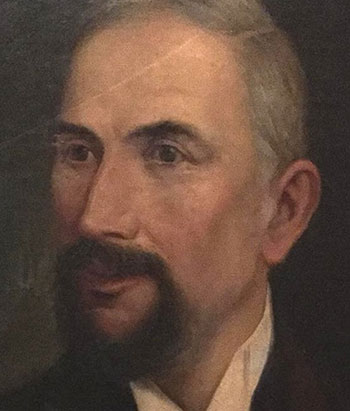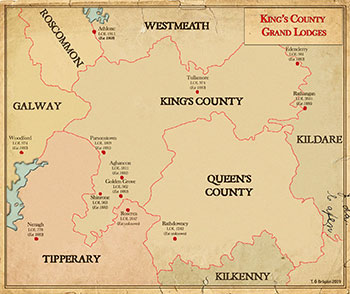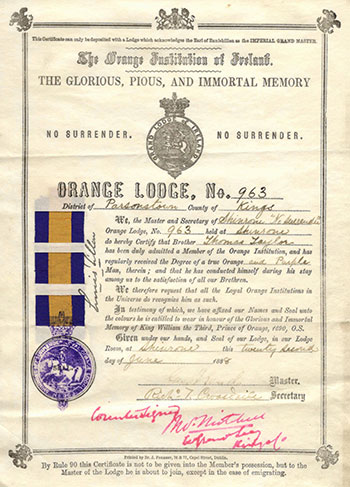All the King’s Men
Published in Features, Issue 6 (November/December 2019), Volume 27The late nineteenth-century Orange revival in King’s County (Offaly).
By Quincey Dougan
In what was named King’s County by Queen Mary during a phase of plantation in 1556, there were five Orange lodges operational in 1798, in the early years of the Orange Institution. While it is highly likely that there were still those within its borders who proudly referred to themselves as ‘Orangemen’, to all intents and purposes King’s County Orangeism was dead as an organised movement from the 1850s until 1880. The events of 1879, however, were to begin a chain reaction that brought it back to life.
Land War
In August that year the Irish National Land League was formed and with it began the Land War, a campaign that included mass meetings, organised withholding of rents, intimidation of landlords and resistance to evictions. In 1881 the Protestant population of King’s County was small but significant at 6,500 (10.4%), and within the landowner, clerical, farmer, trader and professional classes many sought a means of banding together for protection. The means chosen was Orangeism. After several decades in abeyance, in a flurry of activity brand-new Orange lodges were formed in King’s County and neighbouring counties.
The first new lodge was in the county town of Parsonstown (Birr). Within the next eight months three other lodges were formed at Aghancon, Golden Grove and Shinrone, and in December 1881 official permission was granted by the Grand Orange Lodge of Ireland to reform the long-defunct King’s County Grand Orange Lodge to oversee local Orangeism. Within a few years further lodges were formed at Edenderry, Tullamore, Nenagh and Roscrea in Tipperary, Rathdowney in Queen’s County (Laois), and Rathangan in Kildare. A lodge that was already operating in Athlone (Westmeath) came under the wing of the new County Lodge, bringing it to its peak of eleven lodges.
The first county grand master was the 4th earl of Rosse, Lawrence Parsons of Birr Castle. His father William Parsons, the 3rd earl, was the world-renowned astronomer, but his son was a notable figure in his own right. As well as being a peer, he was also lord lieutenant of King’s County, chancellor of Trinity College, a fellow of the Royal Society and president of the Royal Irish Academy. A staunch unionist, upon his death in 1908 the Belfast Weekly News credited him with having ‘kept alive the spirit of Orangeism about Birr’.
John Wright

Above: John Wright, worshipful master of the first revived lodge, Parsonstown LOL 1809, founded in 1881. (Gerard Murphy)
The treasurer of the new county structure was John Wright, who made the first application to form a new lodge. Wright was also the worshipful master of the first revived lodge, Parsonstown LOL 1809. Given this prominent initial role, combined with his background, it could reasonably be speculated that he played a central part in the Orange revival. Born in the home of Orangeism, County Armagh, in Armagh City, and in his early career a journalist with the Armagh Guardian, Wright would have been exposed to Orange traditions and politics from an early age. He purchased the King’s County Chronicle, and under his editorial lead and ownership until his death in 1915 the Chronicle was regarded as an unashamedly Orange and unionist organ.
Within just nine months of its birth, Parsonstown LOL 1809 had a membership of 132 brethren. Its legacy can still be seen in Birr today. In the centre of the town sits the very distinctive Birr Theatre and Arts Centre. The building is commonly referenced as having been the parish hall for St Brendan’s Church of Ireland church, but in fact it was originally the town’s Orange hall. Monies towards the cost were raised through voluntary subscriptions from Protestants in the district, with the Parsonstown lodge prominent in the initial subscription list. It officially opened in January 1889 and in the 1890s was listed on the Grand Orange Lodge of Ireland registry of Orange halls. While usually referred to in the press as Oxmantown Hall (taken from titles previously held by the earls of Rosse), it was occasionally called Parsonstown Orange Hall.
William Peisley Hutchinson Lloyd Vaughan
 The most important of the King’s County Orangemen in this period was William Peisley Hutchinson Lloyd Vaughan, county grand master for over 25 years. Vaughan ran the County Grand Lodge from his impressive home at Golden Grove in the south of the county, a short distance from Roscrea, Co. Tipperary. For over two decades Golden Grove was the focal point for Orange demonstrations, hosting numerous events, and Vaughan went so far as to have an Orange hall in the grounds of his estate.
The most important of the King’s County Orangemen in this period was William Peisley Hutchinson Lloyd Vaughan, county grand master for over 25 years. Vaughan ran the County Grand Lodge from his impressive home at Golden Grove in the south of the county, a short distance from Roscrea, Co. Tipperary. For over two decades Golden Grove was the focal point for Orange demonstrations, hosting numerous events, and Vaughan went so far as to have an Orange hall in the grounds of his estate.
The worshipful master of Roscrea LOL 2047, which met in Golden Grove Orange Hall, was solicitor William Bridge, who appears to have had a close relationship with Vaughan. Both were involved in an interesting incident concerning Orangeism in 1888, when Vaughan sought to recover damages for libel by a King’s County newspaper, the Midland Tribune, which had published a piece that questioned his ability to act impartially as magistrate of Roscrea petty sessions court, specifically because of his Orangeism. Represented by William Bridge, he successfully fought and won the case, being awarded £50 in damages (over £6,000 in today’s money).
The area of King’s County with the most Orange reputation was Shinrone, one contemporary history describing it as a ‘hotbed of rampant Orangeism’. LOL 963 ‘Shinrone No Surrender’ came into being in November 1881, with George Frend as its first worshipful master. Another notable member was Revd Leopold O’Sullivan, the incumbent of St Kieran’s Church of Ireland church, Cloughjordan, Co. Tipperary, and infamous for his anti-Catholic sermons.

Above: An 1888 certificate from Shinrone ‘No Surrender’ LOL 963, a ‘hotbed of rampant Orangeism’.
In newspaper coverage in the late 1880s, it was mentioned on several occasions that Orangemen from Aughrim and east Galway were in attendance at local events. Galway had at least two Orange lodges in the very earliest days of the institution, but by the 1880s they had been defunct for almost half a century. The exact date of the formation of a new Galway lodge is unknown, but by at least 1891 one was meeting at Woodford, the scene of several boycotting incidents.
Edenderry LOL 981 was formed on 3 October 1883 under Worshipful Master William Jonathan Houghton Tyrrell, who would retain that position for almost 40 years. He was the land agent for the Bors family of Ballindoolin House, Co. Kildare, four miles from Edenderry, and when they went bankrupt in the 1890s Tyrrell bought the house.
The period 1885–90 appears to have been the peak of the revived King’s County Orange institution, with large numbers mustering each year to celebrate the main anniversary dates. What seems to have been the largest-ever muster of affiliated Orangemen took place on 12 July 1887 at Golden Grove. It was advertised in advance as a gathering to celebrate both the Twelfth and the ‘Jubilee of her Majesty’, and the Irish Times claimed that about 1,400 people were present. The gathering included the membership of eight lodges, who in traditional Orange fashion held a parade within the house grounds headed by the Dublin Orange Fife and Drum Band.
While much of the reportage on King’s County Orangeism was political, on occasion titbits of information reveal that its lodges were also the important social institutions that they were in Ulster. In November 1885 a ball was held in Golden Grove, hosted by LOL 962 and LOL 2047, with almost 300 brethren and their ‘lady friends’ present. Representatives from the Shinrone, Parsonstown, Aghancon, Rathdowney and Athlone lodges were also present. It was noted that the ballrooms were tastefully decorated and included the century-old flags of the local Yeomanry.
In 1888 another mass event took place in Golden Grove on 12 July, this time mooted as a Liberal Unionist meeting under the auspices of the King’s County Grand Orange Lodge, for the purpose of a celebration of the tercentenary of the defeat of the Spanish Armada and the bicentenary of the Glorious Revolution of 1688. As brethren arrived, the avenue to the house was ‘spanned at intervals with arches bearing mottoes, such as Union and Strength, The Pious and Immortal Memory, and Erin Go Bragh’. In his speech, County Grand Master Lloyd Vaughan stated that ‘if Home Rule were granted there would be nothing left for them but to go from the country or be murdered’, to which a voice came from the crowd, ‘or to fight’.
Grand Orange Lodge of Ireland bi-annual meeting, 1889
Despite a setback to the local movement in December 1888 when LOL 1242 Rathdowney ceased operating and the warrant was handed in, the finest moment in the history of King’s County Orangeism was yet to come. On Wednesday 5 June 1889, in a striking acknowledgement of the success of Orangeism locally, the Grand Orange Lodge of Ireland brought one of its bi-annual meetings to the county. The visit of Grand Lodge was both important and noteworthy because it was one of only two occasions in two centuries that it would meet outside Ulster or Dublin. Once again the base of operations was the home of Lloyd Vaughan at Golden Grove, where over 80 representatives of Orangeism from eleven County Grand Lodges attended.
After an explosion of activity and popularity in the 1880s, the success of local Irish nationalism, in terms of both the land question and politics, made maintaining an Orange identity incredibly difficult, and the opening years of the twentieth century saw the winding up of several lodges in quick succession. The last public statement from the County Grand Lodge, again on Home Rule, came in April 1912, but that December, following a failure to return completed records to the Grand Orange Lodge of Ireland, a committee was appointed to investigate its status. In June 1913, following the presentation of the committee’s report to Grand Lodge, it was proposed and seconded that the King’s County Grand Lodge be dissolved.
Quincey Dougan is a columnist with The Orange Standard, the monthly newspaper of the Grand Orange Lodge of Ireland.
















